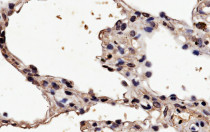ARG64166
anti-Histamine Receptor H1 antibody
anti-Histamine Receptor H1 antibody for IHC-Formalin-fixed paraffin-embedded sections,Western blot and Human
Immune System antibody; Signaling Transduction antibody
Overview
| Product Description | Goat Polyclonal antibody recognizes Histamine Receptor H1 |
|---|---|
| Tested Reactivity | Hu |
| Tested Application | IHC-P, WB |
| Host | Goat |
| Clonality | Polyclonal |
| Isotype | IgG |
| Target Name | Histamine Receptor H1 |
| Antigen Species | Human |
| Immunogen | QQTSVRREDKCETD |
| Conjugation | Un-conjugated |
| Alternate Names | HRH1, Histamine Receptor H1, Histamine H1 Receptor, HH1R, H1R, Histamine Receptor, Subclass H1, HisH1, H1-R |
Application Instructions
| Application Suggestion |
|
||||||
|---|---|---|---|---|---|---|---|
| Application Note | WB: Recommend incubate at RT for 1h. IHC-P: Antigen Retrieval: Microwaved tissue section in Citrate buffer (pH 6.0). * The dilutions indicate recommended starting dilutions and the optimal dilutions or concentrations should be determined by the scientist. |
Properties
| Form | Liquid |
|---|---|
| Purification | Purified from goat serum by antigen affinity chromatography. |
| Buffer | Tris saline (pH 7.3), 0.02% Sodium azide and 0.5% BSA. |
| Preservative | 0.02% Sodium azide |
| Stabilizer | 0.5% BSA |
| Concentration | 0.5 mg/ml |
| Storage Instruction | For continuous use, store undiluted antibody at 2-8°C for up to a week. For long-term storage, aliquot and store at -20°C or below. Storage in frost free freezers is not recommended. Avoid repeated freeze/thaw cycles. Suggest spin the vial prior to opening. The antibody solution should be gently mixed before use. |
| Note | For laboratory research only, not for drug, diagnostic or other use. |
Bioinformation
| Database Links | |
|---|---|
| Background | Histamine is a ubiquitous messenger molecule released from mast cells, enterochromaffin-like cells, and neurons. Its various actions are mediated by histamine receptors H1, H2, H3 and H4. This gene was thought to be intronless until recently. The protein encoded by this gene is an integral membrane protein and belongs to the G protein-coupled receptor superfamily. It mediates the contraction of smooth muscles, the increase in capillary permeability due to contraction of terminal venules, the release of catecholamine from adrenal medulla, and neurotransmission in the central nervous system. Multiple alternatively spliced variants, encoding the same protein, have been identified. [provided by RefSeq, Jul 2008] |
| Research Area | Immune System antibody; Signaling Transduction antibody |
| Calculated MW | 56 kDa |
| PTM | Phosphorylation at sites in the second and third cytoplasmic loops independently contribute to agonist-induced receptor downregulation. |
Images (2) Click the Picture to Zoom In
-
ARG64166 anti-Histamine Receptor H1 antibody WB image
Western blot: Human Heart lysate (35 µg protein in RIPA buffer) stained with ARG64166 anti-Histamine Receptor H1 antibody at 0.5 µg/ml dilution.
-
ARG64166 anti-Histamine Receptor H1 antibody IHC-P image
Immunohistochemistry: Paraffin-embedded Human lung tissue. Antigen Retrieval: Microwaved tissue section in Citrate buffer (pH 6.0). The tissue section was stained with ARG64166 anti-Histamine Receptor H1 antibody at 4 µg/ml dilution followed by HRP-staining.







